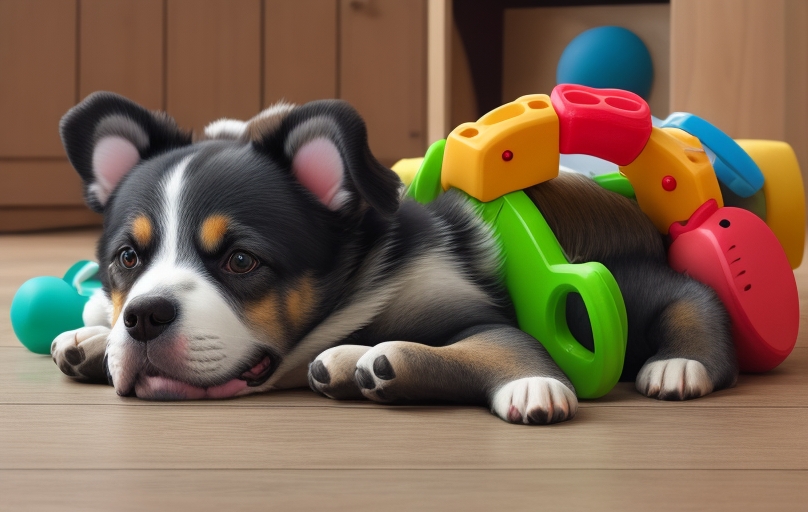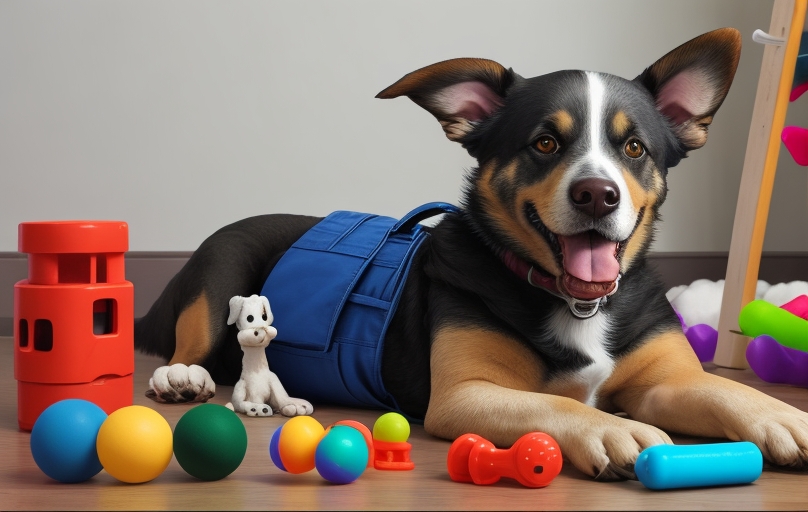In a world full of responsibilities, there’s nothing quite like coming home to the wagging tail and joyful eyes of your furry friend. Why Dogs Need Toys? Dogs are not just pets; they are family. And just like any family member, they need attention, care, and a lot of love. Part of that care involves providing them with toys. But why do dogs need toys? Let’s explore this question in detail.
Scientific Research Insights
Title: “Effects of Toys on the Behavior and Welfare of Kennelled Dogs”
This study examines the impact of toys on the behavior and welfare of kennelled dogs. The research found that providing toys to dogs in a kennel environment reduced stress, boredom, and behaviors associated with anxiety. Toys were shown to be crucial in enhancing the overall well-being of dogs in a confined space.
Title: “Environmental Enrichment for Dogs: Review and Behavioral Results”
This comprehensive review and study highlight the importance of environmental enrichment, including toys, in enhancing the behavior and well-being of dogs. The research discusses how toys can reduce undesirable behaviors and improve the overall quality of life for dogs.
Title: “The Importance of Play in the Home Environment for Dogs”
This study focuses on the significance of play and play objects, such as toys, in the home environment for dogs. It provides insights into how play can improve the relationship between dogs and their owners, enhance the dog’s well-being, and help address behavioral problems.
These scientific research studies underline the positive impact of toys on the behavior and welfare of dogs, emphasizing the importance of providing them with toys for both mental and physical stimulation.
Read Also: How Do I Make My Dog Has The Best Life?
Why Dogs Need Toys
The Importance of Toys for Dogs

1. Mental Stimulation
Dogs are intelligent creatures, and they need mental stimulation to keep their minds active and healthy. Toys can be instrumental in providing this stimulation. Puzzle toys, for example, challenge their problem-solving abilities and prevent boredom.
2. Physical Exercise
Dogs also need physical exercise to stay fit and healthy. Toys like fetch balls, frisbees, and tug-of-war ropes can help them burn off energy, maintain a healthy weight, and improve their cardiovascular health.
3. Emotional Well-being
Just like humans, dogs experience a wide range of emotions. Toys can act as companions when their human friends are not around, alleviating feelings of loneliness and separation anxiety.
4. Dental Health
Chewing is a natural instinct for dogs, and it’s essential for their dental health. Toys like chew bones and dental sticks help clean their teeth, prevent tartar buildup, and maintain fresh breath.
5. Stress Relief:
Toys can serve as a source of comfort and stress relief for dogs, especially in situations where they might be anxious or left alone for extended periods. Chew toys and comfort toys can help ease separation anxiety and provide a sense of security.
6. Preventing Destructive Behavior:
Dogs that are bored or anxious may resort to destructive behaviors like chewing on furniture, shoes, or other household items. Providing them with toys can redirect their chewing behavior towards something more appropriate.
7. Bonding and Social Interaction:
Playing with toys is an excellent way for you to bond with your dog. Interactive toys, such as fetch or tug-of-war toys, can enhance your relationship and strengthen the bond between you and your pet.
8. Training and Enrichment:
Toys can be used as tools for training and enrichment. Puzzle toys and treat-dispensing toys can challenge a dog’s problem-solving skills and provide mental enrichment. These toys can also be used in training sessions to reward and motivate your dog.
9. Independence:
Toys can help dogs entertain themselves when their owners are not available to interact with them. This is especially valuable for dogs left alone during the day or when you’re busy with other tasks.
Choosing the Right Toys

Size Matters
Select toys that are appropriate for your dog’s size. Larger breeds may require sturdier toys, while smaller dogs need smaller toys to prevent choking hazards.
Durability
Invest in toys made from durable materials to withstand your dog’s enthusiastic playtime. Look for toys labeled as “indestructible” or “heavy-duty” for strong chewers.
Safety First
Always prioritize your dog’s safety. Avoid toys with small parts that can be swallowed, and regularly check for any signs of wear and tear in their toys to prevent accidents.
Types of Toys

Interactive Toys
Interactive toys, such as treat-dispensing puzzles, engage your dog’s mind and provide hours of entertainment while rewarding them with treats.
Squeaky Toys
Squeaky toys can be a source of joy for dogs, as they mimic the sounds of prey, triggering their hunting instincts and keeping them entertained.
Plush Toys
Plush toys are perfect for cuddle time and comfort. Many dogs enjoy carrying them around like a security blanket.
DIY Toys
Homemade Delights
If you’re feeling creative, consider making homemade toys using safe materials like old t-shirts, tennis balls, or empty plastic bottles.
When to Replace Toys
Monitor Wear and Tear
Regularly check your dog’s toys for signs of damage. If you notice any broken pieces or frayed edges, it’s time to replace the toy to prevent any harm to your pet.
Read Also: 7 reasons why dog toys are so important.
Conclusion:
In conclusion, providing your dog with a variety of toys is not just a luxury; it’s a necessity. Toys play a crucial role in your dog’s physical and mental well-being, keeping them happy and healthy. So, indulge your furry friend with the gift of play!
FAQs
1. How many toys should I have for my dog?
It’s a good idea to have a variety of toys, but a minimum of 4-5 toys is a good starting point. Rotate them regularly to keep your dog engaged.
2. Are there any specific toys for teething puppies?
Yes, there are teething toys designed to soothe your puppy’s sore gums. Look for toys that are soft and gentle on their developing teeth.
3. Can toys help in training my dog?
Yes, toys can be used as rewards in training sessions. They provide positive reinforcement and motivation for your dog.
4. Are there any toys to reduce separation anxiety?
Interactive toys and puzzle feeders can help reduce separation anxiety by keeping your dog engaged while you’re away.
5. How can I clean my dog’s toys?
Most dog toys can be cleaned with mild soap and water. Follow the manufacturer’s instructions for specific cleaning recommendations.
- Reference: Wells, D. L., & Hepper, P. G. (2000). Effects of Toys on the Behavior and Welfare of Kennelled Dogs. Animal Welfare, 9(4), 207-220.
- Reference: Anderson, R. K., Cannon, K. C., Hulse, S. E., & Pennell, A. (1996). Environmental Enrichment for Dogs: Review and Behavioral Results. Applied Animal Behaviour Science, 47(1-2), 7-49.
- Reference: Rooney, N. J., & Bradshaw, J. W. (2002). The Importance of Play in the Home Environment for Dogs. The Journal of Veterinary Behavior, 1(3), 74-81.

1 thought on “Why Dogs Need Toys: A Comprehensive Guide”